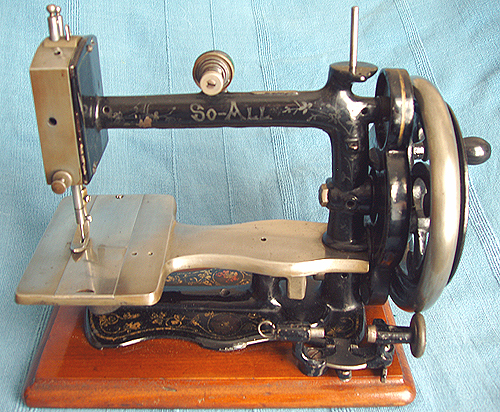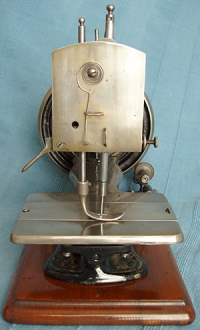| Bradbury & Co. | Busy Bee Co. |
Franklin Sewing Machine Co. |
Heron, Gresham & Craven |
Howe Machine Co. |
Imperial Sewing Machine Co. |
Jones & Co. |
|
Moldacot Pocket Sewing Machine Co. |
Newton Wilson & Co. | Oldham Manufacturers |
Royal Sewing Machine Co. |
William Sellers | Shepherd, Rothwell & Hough |
Singer Sewing Machine Co. |
| W.F. Thomas & Co. | Smith, Starley & Co. | Edward Ward | James Weir | Other British Manufacturers |
A-Z of British Manufacturers |
The Gallery | Contact Us |
Other British Sewing Machine
Manufacturers
This web page was created by David BestŠ2007 - 2012 see copyright notice below
The sewing machines shown on this page were made by various British manufacturers, although many of the Company names will be unfamiliar except to enthusiasts who seek to preserve and promote Britain's Industrial Heritage from a time Britain was truly Great.
Both The Singer Manufacturing Co. and The Howe Machine Co. have been classed as British manufacturers as both these American Companies established factories in Glasgow, Scotland. In fact Singers Kilbowie works became the largest sewing machine factory in the World.
In order to speed up load time we've listed some British manufactuers on separate pages, click on the links above for more British makers.


So-All Serial No. 3692.
In 1889 Wilmot Holland, a merchant purchased various sewing machine patents and started business as the So-All Sewing Machine Co.
The machines were manufactured by Kimball & Morton, Glasgow and the initial order was for 12,000 machines at a cost of 14s 6d each. Premises we taken in Lombard Street, London but in October 1889 new show rooms were opened at 3 Oxford Street, London.
The So-All originally sold for 35s and a stand and cover cost an additional 25s.
The So-All was however, spectacularly unsuccessful, in just over three years only 2,000 machines were sold with a large wholesale firm buying 1,000 of those at 5s each.
After one failed attempt to form a public company a second prospectus was issued in December 1892 and this also failed. Early in 1893 Wilmot Holland had a receiving order made against him.
This is an early version of the So-All made in 1889. It has a plain steel needle head and the cloth plate is polished cast iron, on later versions the cloth plate was jappaned.
The So-All was unusual in that it used the needle to draw the material across the cloth plate rather than the more common four motion feed hence the unusually wide needle head.

Varley Family: Serial No. 66844 S100.
It is a fiddle base Family machine, with a Daffodil scroll decal and the Royal Coat of Arms to the centre bed. The black strip on the front of the base was originally a ruler in Imperial units.
The bobbin winder shares features with a Jones Hand and the hand crank handle is wood. It has a really neat lid, see the Cases & Bases Page
The same type of machine was badged and sold through J. D. Williams, Manchester it had a centre decal similar to that on the Jones T.S. with the word Family across it.


Varley Medium: Serial No. 70705 F61.
Produced by Varley and Co. Keighley, Yorkshire, and sold through a retailer - Fattorini & Sons, Bradford whose name can just be made out on the arm.
This is a Medium machine but has virtually identical decals to the Family machine shown above. Although it would probably have been used by a dressmaker or tailor it could also sew leather. We think this machine would date to the 1890's.

Antonio Fattorini started business in Leeds in 1827 moving to Harrogate in 1831. In 1846 he and his sons John and Edward established a Jewellery business in Bradford. In 1897 they made the first Rugby League Challenge Cup and in 1911 the F. A. Cup.
The firm had a mail order business which was sold to Empire Stores in 1910.
The stand and case are shown on the Cases & Bases Page

Kimball & Morton 'Oscillator':
Serial No.122790.
The Oscillator seems to have been introduced in 1886, early versions, certainly up to 1889 had a different decal pattern and the wood work was less ornate. This machine would probably date to the late 1890's, the head has a floral decal and Mother of Pearl flakes along the front and rear edges of the bed. The shuttle is quite small and is positioned vertically beneath the slide plate.
The head is in a four drawer table, with an extension flap. The stand is quite substantial, there are rampant Lions cast into the sides. The treadle stand on the Oscillator is very robust with a large wheel compared to other machines, but the foot plate is quite small.
The case was not as well made, being only thin ply and requires restoration. It has a pretty central panel. The locking mechanism is unusual, a lever action swings a 'rod' under the arm of the machine.





Ideal
This unusual machine was made by the Ideal Sewing Machine Co. Ltd. c1920. The design was Patented by Leslie Salter in 1910, however it's believed that the First World War prevented the machine actually going into production.
The company produced two versions of this machine - this is an example of the "A" type. The "B" type featured various improvements and can easily be identified by it's face plate.
The machines do not appear to carry a serial number and it is not known how many of each model were produced, nor if the two versions were produced concurrently or consecutively.
The machine is a chain stitch type using a walking foot cloth feed. The spool pin is located horizontally on the rear of the arm and is a push fit - Willcox & Gibbs style. Note how rough some of the castings are in particular, the gear cover and balance wheel.
Completely Nickel-plated the machine has a painted sheet steel domed cover with the Company's Trade Mark on the front. The case is held in place by three prongs which protrude from the wooden base and which align with holes and a hasp on the case.


Vickers Modele de Luxe: Serial No. C1-15065.
Made by Vickers Ltd who were more famous for armament production than sewing machines. The Company started producing sewing machines on a small scale during World War One at Hackney Wick and later at the company's Crayford Works. Production continued until the late 1940's. This machine is a copy of a Frister & Rossmann V.S. and was made c1920.


BSM: Serial No. 7/009021.
Made for British Sewing Machines Ltd, London by Vickers c1930, this model was also produced with a white, blue or yellow body. Early production examples carry the Vickers name as well as the B.S.M. logo.
This machine is in reasonable condition but has long since lost its cover, the machine was designed so it could be used as a treadle with holes in the base for the treadle belt to pass through. Over 32,000 of this model were produced.
The firm also produced an electrically operated rotary hook machine as well as an oscillating shuttle machine designated Type No. 3 A. The Company was known to be operating until at least 1945 and had premises at Lombard Road, Morden Road, London SW19.

Tailor Bird: Serial No. 8115.
Made at Richborough Hall, Sandwich, Kent in the late 1940's or early 1950's (the company had ceased production by May 1952). Its body is made from pressed steel (rather than cast iron) and it appears to have been designed as a truly compact, light weight, portable machine, ingeniously folding in/out of its case. But it received much bad publicity and was not particularly successful despite being guaranteed for 5 years.
The Case of this machine is shown on the Cases & Bases Page

